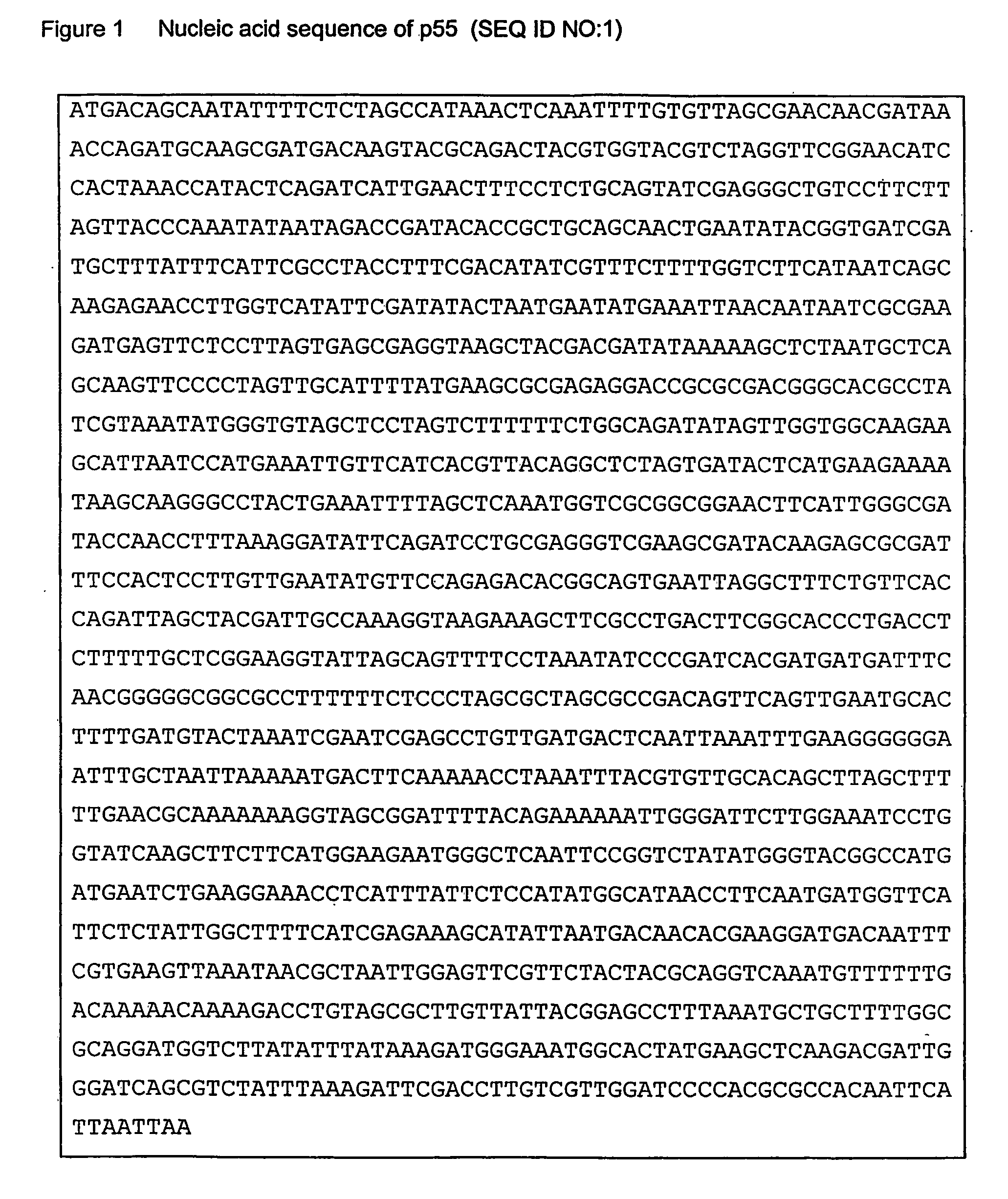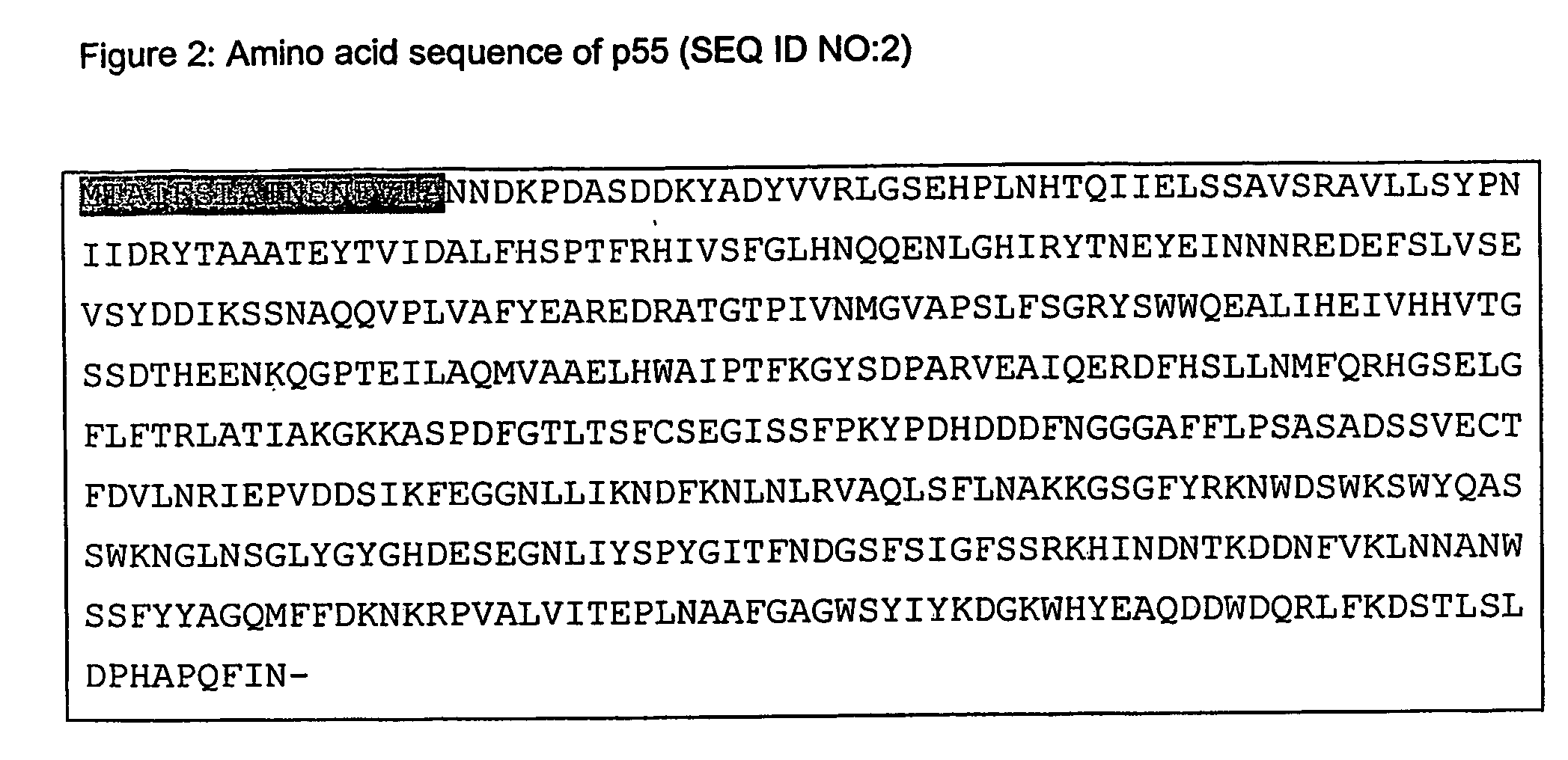Protein from photobacterium damselae and use thereof
a technology of photobacterium damselae and protein, which is applied in the field of new secreted protein of photobacterium damselae, can solve the problems of ineffective antibiotic therapy, undesirable, slow development of a vaccine against this disease, and high variability in the efficacy obtained with these bacterins
- Summary
- Abstract
- Description
- Claims
- Application Information
AI Technical Summary
Benefits of technology
Problems solved by technology
Method used
Image
Examples
example 1
Cloning and Sequencing of p55 from Ph. Damselae subsp. piscicida
[0052]Ph. damselae bacteria (strain MT1415) are grown in tryptic soy broth (TSB) supplemented with NaCl to a final concentration of 1% (w / v) (TSB-1) at 22° C. with shaking (100 rpm) to an optical density at 600 nm of approximately 0.6 (mid-exponential phase). Bacterial cells are removed by centrifugation and subsequent filtration through a 0.22 μm pore size filter. Cell-free supernatants are concentrated 100-fold using a Vivaflow 200 concentrator (Sartorius AG, Goettingen), and dialysed against 20 mM Tris-HCl (pH 8.0).
[0053] Concentrated culture supernatants are subjected to SDS-PAGE. The 55 kDa band is excised from the gel after Coomassie-blue staining. In situ tryptic digestion of the purified protein and Edman degradation of two HPLC-purified peptides is performed.
[0054] The fragments yield the following sequences: NNDKPDASDDKYADYVVR and YTAAATEYTVIDALFHSPTFR. The underlined regions are used to design degenerate p...
example 2
Expression of p55 in E. coli
[0058] PCR fragments containing the full length p55 gene are cloned into two different expression vectors: pET-28a(+) (Novagen) and pQE-31 (Qiagen), yielding the recombinant plasmids pETp55 and pQEp55, respectively. E. coli cells are transformed by conventional methods and transformants are grown at 37° C. with shaking for 8 hours in Luria Broth (LB) supplemented with 50 μg / ml kanamycin or with 50 μg / ml kanamycin plus 200 μg / ml ampicillin for the BL21 E. coli strain (pET-28 (+) vectors) and M15 E. coli strain (pQE-31 vectors), respectively. These cultures are diluted 1:100 in fresh LB with the respective antibiotics and grown for 3 hours at 37° C. with shaking. IPTG is then added to a final concentration of 1 mM and growth continues for 5 hours at 37° C. IPTG-induced cells are pelleted by centrifugation.
[0059] SDS-PAGE analysis of E. coli cells carrying the pETp55 plasmid reveals a robust expression of a non-soluble (present in the inclusion bodies frac...
example 3
Passive Immunization Using Rabbit Antiserum to Photobacterium 55 kDa Protein (Three Independent Experiments are Carried Out)
[0060] Fish: European sea bass (Dicentrarchus labrax) having a body weight of about 100 g are held in glass aquaria with UV sterilized sea water supplied through a biofilter in a recirculating system. The water temperature is a constant 23±1° C. and salinity is 35%.
[0061] Production of Immune serum: Hyperimmune serum against the 55 kDa protein is raised in rabbits using 3 doses of the purified protein emulsified in Freund's incomplete adjuvant. The purified p55 protein is prepared as follow. Concentrated culture supernatants from strain MT1415 prepared as described in Example 1 above are subjected to Coomassie-blue SDS-PAGE. After electrophoretic separation, the 55 kDa band is excised from the gel, minced in elution buffer (0.02% SDS, 10 mM beta-mercaptoethanol, 34 mg / ml PMSF) and incubated overnight at 4° C. with shaking. The acrylamide suspension is then ce...
PUM
| Property | Measurement | Unit |
|---|---|---|
| dry weight | aaaaa | aaaaa |
| body weight | aaaaa | aaaaa |
| body weight | aaaaa | aaaaa |
Abstract
Description
Claims
Application Information
 Login to View More
Login to View More - Generate Ideas
- Intellectual Property
- Life Sciences
- Materials
- Tech Scout
- Unparalleled Data Quality
- Higher Quality Content
- 60% Fewer Hallucinations
Browse by: Latest US Patents, China's latest patents, Technical Efficacy Thesaurus, Application Domain, Technology Topic, Popular Technical Reports.
© 2025 PatSnap. All rights reserved.Legal|Privacy policy|Modern Slavery Act Transparency Statement|Sitemap|About US| Contact US: help@patsnap.com


